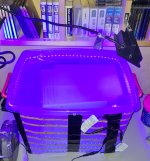JC8080
Well-known member
I have an SE/30 case I've been wanting to retrobrite, and due to space and geographical factors, I don't have the ability to leave parts sitting out in sunlight. I've seen a couple videos online where people use UV lights indoors. One video I ran across a while back used a UV LED strip with some success, the kind you buy in a spool off Amazon. Since I would be doing the large back case the submersion method is impractical, so I was thinking of using the salon cream. My thought is this would take place in a bath tub, either on some sort of tray or in a plastic tub to contain any of the cream that dripped off. Does anyone have any experience with this?



